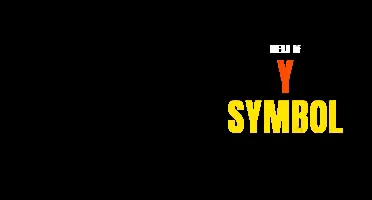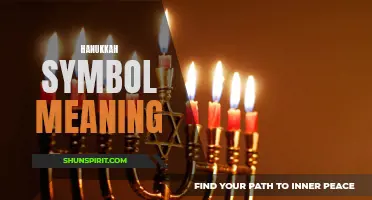
Have you ever heard of Chrismons? These intricate symbols have a rich history and deep meaning in Christian traditions. Chrismons, which are created using different materials, such as beads and wire, represent various aspects of the Christian faith, including the Holy Trinity, the birth, life, and death of Jesus Christ, and the attributes of God. They are often used to decorate Christmas trees in churches and homes during the holiday season. In this article, we will explore the fascinating world of Chrismons symbols and uncover their hidden meanings. So, grab a cup of hot cocoa, sit back, and embark on a journey into the magical realm of Chrismons.
What You'll Learn
- What is the significance of chrismons symbols in Christian traditions?
- What are some common chrismons symbols and their meanings?
- How do chrismons symbols differ from other religious symbols used in Christianity?
- What is the history and origin of chrismons symbols?
- How are chrismons symbols used in worship and decoration during the Christmas season?

What is the significance of chrismons symbols in Christian traditions?
Chrismons are symbols that hold great significance in Christian traditions. The term "chrismon" is a combination of the words "Christ" and "monogram," representing the monograms or symbols associated with Jesus Christ. These symbols are often used during Christmas and are intended to remind Christians of the significance of Jesus' birth and His role in their faith.
The use of chrismons dates back to the mid-20th century when Frances Spencer and her husband, Fredrick, developed the idea of creating handmade ornaments depicting various Christian symbols. The couple wanted to create a visual representation of the story of Christ's birth and the Christian faith. They used different materials such as gold beads, pearls, and wire to craft these symbols, which would later be known as chrismons.
One of the most common chrismons is the chi-rho symbol, a monogram of the first two letters of the Greek word for Christ. This symbol represents Jesus' divinity and is often displayed prominently on chrismon trees or as standalone ornaments. Another popular symbol is the fish, which has long been associated with Jesus and His disciples. The fish symbolizes the miracle of the loaves and fishes, as well as the call to be "fishers of men" as described in the Bible.
Each chrismon symbol holds its own meaning and significance. For example, the lamb symbolizes Jesus' role as the sacrificial lamb, who takes away the sins of the world. The crown represents Jesus as the King of Kings and Lord of Lords. The cross, of course, represents Jesus' crucifixion and ultimate sacrifice for humanity's salvation.
The significance of chrismons goes beyond their visual appeal. They serve as a reminder of the central message of Christianity – the birth, life, death, and resurrection of Jesus Christ. By incorporating these symbols into their Christmas decorations, Christians are reminded of the true meaning of the holiday season and their faith.
Chrismon trees, adorned with these symbols, are commonly found in churches and Christian homes during the Christmas season. They serve as a visual representation of the Christian faith and a reminder of the reason for celebrating Christmas. Each chrismon ornament added to the tree symbolizes a different aspect of Christ's life or teachings, providing a meaningful visual narrative of the Christian story.
Additionally, chrismons can be used as teaching tools. Children and adults alike can learn about the stories and symbolism behind each symbol, deepening their understanding of the Christian faith. During religious education classes or family gatherings, chrismons can spark important discussions about Jesus' life and the significance of His birth.
In conclusion, chrismons hold great significance in Christian traditions. These symbols serve as visual reminders of Jesus' birth, life, and teachings. The use of chrismons during the Christmas season helps Christians to focus on the true meaning of the holiday and their faith. Chrismon trees adorned with these symbols serve as a visual narrative of the Christian story and provide opportunities for education and discussion. Ultimately, the chrismons remind Christians of their belief in Jesus Christ and His central role in their lives.
Understanding Mitsubishi Mirage Dashboard Symbols and Their Meanings
You may want to see also

What are some common chrismons symbols and their meanings?
Chrismons are Christ-centered ornaments that are commonly used to decorate Christmas trees. These symbols have deep religious meanings and serve as reminders of the birth, life, and teachings of Jesus Christ. Understanding the meaning behind these symbols can help deepen one's faith and enhance the spiritual atmosphere during the Christmas season.
One common Chrismon symbol is the Alpha and Omega. The Alpha (Α) and Omega (Ω) are the first and last letters of the Greek alphabet, symbolizing that Christ is the beginning and the end. This symbol reminds Christians that Jesus is the eternal God who existed before time and will continue to exist for eternity.
Another significant Chrismon symbol is the Chi-Rho. The Chi (X) and Rho (P) represent the first two letters of the Greek word "Christos," meaning Christ. This symbol, often combined into one monogram (☧), is one of the oldest Christograms and is a powerful reminder of Jesus' redemptive work and his role as the Messiah.
The cross is another widely recognized Chrismon symbol. It represents the crucifixion and sacrifice of Jesus on the cross for the forgiveness of humanity's sins. The empty cross, often depicted without Jesus, is a reminder of his resurrection and victory over death. The cross is the ultimate symbol of God's love and grace towards humanity.
Another important Chrismon symbol is the fish. The fish was used as a secret symbol among early Christians during times of persecution. The Greek word for fish, "ichthys," served as an acronym for "Jesus Christ, Son of God, Savior." This symbol represents Jesus' identity as the Messiah and the savior of the world.
The dove is yet another significant Chrismon symbol. It represents the Holy Spirit and is often associated with peace, purity, and the presence of God. The dove descended upon Jesus during his baptism, signifying the anointing of the Holy Spirit and the beginning of his ministry.
The star is a common Chrismon symbol that symbolizes the star of Bethlehem, which guided the wise men to the birthplace of Jesus. It represents divine guidance, hope, and the light of Christ that shines in the darkness. The star reminds Christians to seek Jesus and follow his teachings as the guiding light in their lives.
The lamb is a Chrismon symbol often associated with Jesus as the "Lamb of God." It represents Jesus' sacrificial death and his role as the ultimate atoning sacrifice for the sins of humanity. The lamb symbolizes purity, innocence, and the redemption offered through Christ.
These are just a few examples of the common Chrismon symbols used to decorate Christmas trees and enhance the spiritual atmosphere during the holiday season. Each symbol carries a deep meaning and serves as a reminder of Jesus' birth, life, teachings, and redemptive work. By incorporating these symbols into Christmas decorations, Christians can create a sacred space and reflect on the significance of Christ's presence in their lives.
Decoding the Symbolic Meaning behind the Roc Nation Logo
You may want to see also

How do chrismons symbols differ from other religious symbols used in Christianity?
Chrismons symbols are unique to the Christian faith and hold a special significance for believers. These symbols are often used during the Christmas season to represent various aspects of the life, ministry, and teachings of Jesus Christ. While there are several religious symbols used in Christianity, Chrismons symbols differ in their specific representation and meaning.
Firstly, Chrismons symbols are distinct in their design and origin. The term "Chrismon" is derived from two words: "Christ" and "monogram." These symbols are typically made from white and gold materials, representing purity and divinity. They are intricately crafted and designed to reflect the glory and majesty of Christ. Many Chrismons symbols feature geometric shapes, such as triangles, circles, and crosses, which hold symbolic meanings in Christianity.
Secondly, Chrismons symbols differ from other religious symbols in their focus on Christ and the Christian faith. While other religious symbols, such as the cross or the fish, may be used to represent Christianity in general, Chrismons symbols specifically highlight the life and teachings of Jesus Christ. Each Chrismon symbol represents a specific aspect of Christ's life or his attributes, such as the Alpha and Omega symbol representing Christ as the beginning and the end, or the Ichthys fish symbol representing his identity as the "fisher of men."
Additionally, Chrismons symbols are often used in a specific context, primarily during the Christmas season. These symbols are often displayed on Christmas trees or used in various decorations, such as wreaths or banners. The use of Chrismons symbols during this time helps to remind believers of the significance of Christ's birth and his role as the Savior of mankind. These symbols serve as a visual representation of the central message of Christianity and help to create a meaningful atmosphere for worship and celebration.
Furthermore, Chrismons symbols are deeply rooted in the Christian tradition and have been embraced by many denominations and churches. While other religious symbols may vary in their interpretation and usage among different Christian groups, Chrismons symbols are widely recognized and understood. They provide a common visual language that unifies believers and reinforces their shared beliefs and values.
In conclusion, Chrismons symbols hold a unique place among the religious symbols used in Christianity. They are distinct in their design, focus, and usage. These symbols reflect the life and teachings of Jesus Christ and serve as a visual representation of the Christian faith. Through their use during the Christmas season, Chrismons symbols help believers to remember and celebrate the birth of Christ and his role as the Savior of mankind.
The Symbolic Meaning of the White Butterfly: Unveiling Messages from the Spirit Realm
You may want to see also

What is the history and origin of chrismons symbols?
The history and origin of Chrismons symbols can be traced back to the mid-20th century and have become an integral part of many Christian Christmas traditions.
The term "Chrismons" is a combination of the words "Christ" and "monogram." These symbols are used primarily in Christian churches and homes during the Christmas season to represent the birth and life of Jesus Christ.
The concept of using symbols that represent Christ has been around for centuries, but it wasn't until the 1950s that the idea of Chrismons was introduced. The symbols were initially created by Frances Kipps Spencer, who was a member of Ascension Lutheran Church in Danville, Virginia. She wanted to find a way to help her congregation better understand the meaning of Christmas and the significance of Jesus' birth.
Spencer began by creating simple white and gold monograms of Christ's name, using Greek letters such as Chi (X) and Rho (P), which are the first two letters of the Greek word for Christ. These symbols were placed on the Christmas tree in the church, and each one had a biblical meaning associated with it. For example, the Chi-Rho symbol represents the first two letters of Christ's name and is associated with his identity as the Son of God.
As the popularity of Chrismons grew, other churches and individuals began creating their own symbols, expanding the collection beyond just monograms. Today, there are hundreds of different symbols that are used as Chrismons, each with its own unique meaning and representation.
The symbols used in Chrismons are typically made from white and gold materials, representing purity and majesty. They are often made from materials such as beads, ribbons, and metal wires, and can be as simple as a cross or as complex as a detailed nativity scene.
In addition to being used on Christmas trees, Chrismons symbols can be found woven into banners, displayed on church walls, and used in other decorations throughout the Christmas season.
Chrismons have become a cherished tradition in many Christian churches, with families and congregations using them as a way to reflect on the birth of Christ and the message of hope and salvation that he brings. They serve as a visual reminder of the true meaning of Christmas and help to create a sacred and reverent atmosphere during the holiday season.
In conclusion, the history and origin of Chrismons symbols can be traced back to the 1950s when Frances Kipps Spencer created the first monogram symbols to represent Christ. Since then, the use of Chrismons has grown and become an important part of Christian Christmas traditions, serving as a reminder of the birth and life of Jesus Christ.
Decoding the Hidden Symbolism of Kente Cloth: Exploring the Meaning Behind the Patterns and Designs
You may want to see also

How are chrismons symbols used in worship and decoration during the Christmas season?
During the Christmas season, Chrismons symbols are commonly used in worship and decoration to represent the Christian faith and the birth of Jesus Christ. These symbols hold deep meaning and are often displayed on Christmas trees, in churches, and in homes.
Chrismons, a combination of "Christ" and "monogram," were first introduced in the mid-20th century by a Lutheran pastor named Frances Kipps Spencer. These symbols are typically white and gold, symbolizing purity and divinity. They are made from various materials, such as paper, fabric, beads, or metal, and often feature geometric shapes combined with Christian symbols.
In worship, Chrismons symbols are incorporated into the Advent season, which begins on the fourth Sunday before Christmas. They can be used in a variety of ways, depending on the specific traditions and practices of each church. For example, Chrismons may be hung on an Advent wreath or placed on an altar as a visual reminder of the upcoming celebration of Christ's birth. Some churches also have Chrismons trees, where members of the congregation can hang symbols during the Advent season.
Chrismons symbols are also widely used in Christmas decorations, both in churches and in homes. Many individuals and families have adopted the tradition of having a Chrismons tree alongside or instead of a traditional Christmas tree. A Chrismons tree is adorned solely with these symbols, each representing a different aspect of the Christian faith. These symbols may include crosses, crowns, doves, fish, or various other images associated with Jesus, the Holy Spirit, or biblical stories.
The act of decorating a Chrismons tree can be a meaningful and reflective experience. As each symbol is carefully placed on the tree, individuals can meditate on the importance of the Christmas season and the significance of Christ's birth. It serves as a visual reminder of the central message of Christianity and can deepen one's connection to their faith.
In addition to trees, Chrismons symbols can be used in other forms of decoration. They are often incorporated into wreaths, garlands, and centerpieces, adding a touch of religious symbolism to holiday decor. Chrismons ornaments can also be given as gifts, allowing individuals to share their faith with loved ones.
Overall, Chrismons symbols play a significant role in worship and decoration during the Christmas season. They serve as powerful reminders of the Christian faith and the celebration of Christ's birth. Whether displayed in churches or homes, these symbols add a deeper spiritual dimension to the holiday season and bring people closer to the true meaning of Christmas.
Exploring the Rich Symbolic Meaning Behind Native American Horse Imagery
You may want to see also
Frequently asked questions
Chrismons are special Christian symbols that are typically made and used during the Christmas season. They are meant to represent different aspects of the Christian faith and the story of Jesus' birth. Each symbol has its own unique meaning, such as the Latin Cross symbolizing Jesus' sacrifice on the cross and the Alpha and Omega symbol representing the eternal nature of God.
Yes, there are specific colors often used in Chrismons that hold symbolic meaning. White is commonly used to represent purity and innocence, symbolizing Jesus' sinless nature. Gold is used to represent the glory and majesty of God, while silver symbolizes redemption and purification. Blue can also be used to represent heaven and the divine.
Anyone can make and use Chrismons, regardless of their church or denomination. The symbols and their meanings are generally accepted within the wider Christian community. However, they may be more commonly used in certain churches or traditions that place a stronger emphasis on symbolic imagery and decorations during the Christmas season. Ultimately, the use of Chrismons is a personal decision for each individual or church community.







